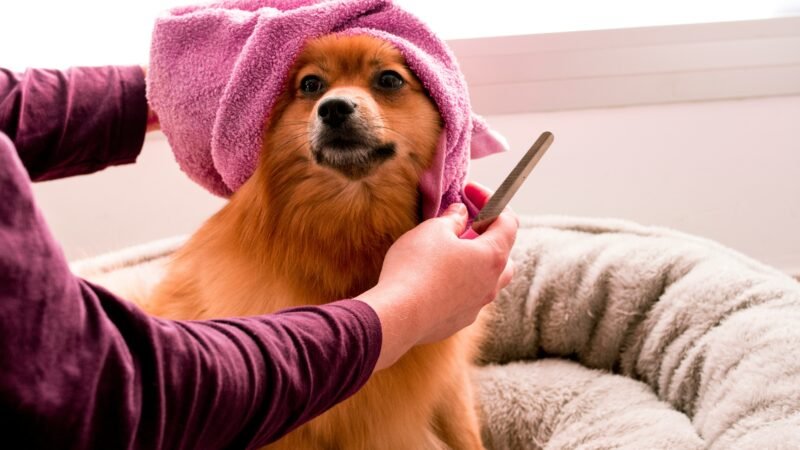Dog Grooming for Beginners:
A Complete Guide for New Pet Owners
Dog grooming isn’t just about making your dog look cute—it’s an essential part of their overall health and comfort. Establishing a regular grooming routine can help prevent skin problems, catch potential health issues early, and strengthen the emotional bond between you and your pup.

1️⃣ Create a Calm and Comfortable Grooming Environment
Choose a quiet, well-lit, non-slip area for grooming.
Groom your dog when they are relaxed, such as after a walk or play session.
Prepare treats to reward good behavior and build a positive association with grooming.
2️⃣ Six-Step Dog Grooming Routine
✅ Step 1: Brushing (Daily to Weekly)
Removes dirt and dead hair, prevents tangles, and helps distribute natural oils.
Short-haired dogs: Brush once a week.
Long-haired dogs: Daily brushing recommended.
Recommended tools: slicker brush, bristle brush, undercoat rake.
✅ Step 2: Nail Trimming (Every 3–4 Weeks)
Overgrown nails can affect walking posture and cause discomfort.
Avoid cutting the “quick”—trim only the tips.
Use pet nail clippers or a grinder; keep styptic powder on hand in case of bleeding.
✅ Step 3: Bathing (Every 4–8 Weeks)
Use lukewarm water and a dog-specific shampoo.
Insert cotton balls into the ears to prevent water from entering; avoid contact with the eyes.
Rinse thoroughly to prevent shampoo residue from irritating the skin.
✅ Step 4: Drying
Towel-dry until damp, then use a blow dryer on a low heat setting.
Brush while drying to prevent tangles and help the coat dry evenly.
✅ Step 5: Ear Cleaning, Tooth Brushing & Anal Gland Care
Use pet-safe ear cleaner to gently clean the ears; do not insert anything deep into the ear canal.
Brush your dog’s teeth 1–2 times per week with dog-friendly toothpaste.
If you notice odor or swelling near the anal area, express the anal glands gently (best done with guidance from a vet).
✅ Step 6: Hair Trimming
Trim hair around the paw pads, anus, and eyes for hygiene.
Use rounded scissors or pet clippers carefully to avoid injury.
Finish with a final brushing and consider applying a leave-in conditioning spray for shine.
3️⃣ Grooming Frequency Guide by Coat Type
Coat Type | Brushing Frequency | Bathing Frequency |
Short-haired dogs | Once per week | Every 4–6 weeks |
Medium/long-haired | Daily or every other day | Every 4–8 weeks |
Double-coated dogs (e.g., Huskies) | 2–4 times per week | Monthly + extra care during shedding seasons |
4️⃣ Why Regular Grooming Is Important
Health Checks: Brushing helps spot lumps, skin issues, or parasites early.
Skin & Coat Health: Distributes natural oils, reduces matting and inflammation.
Emotional Bonding: Calm grooming builds trust and reduces anxiety.
Cleanliness & Fresh Smell: Keeps your dog clean, reduces odor, and improves the home environment.
5️⃣ Must-Have Dog Grooming Tools
Slicker brush, bristle brush, undercoat rake (based on coat type)
Pet nail clippers or nail grinder
Styptic powder
Dog shampoo and conditioner
Cotton balls and ear cleaner
Dog toothbrush and toothpaste
Clippers or round-tip grooming scissors
Towels and a low-heat blow dryer
Treats (to reward good behavior and reduce stress)
6️⃣ Further Reading
✅ Conclusion & Pro Tips
Dog grooming is a must-learn skill for every responsible pet owner. With the right tools and a consistent routine, you can keep your dog healthy, clean, and happy. Take it slow, start with the basics, and help your dog gradually get used to grooming—it can become a relaxed and joyful part of your daily life together.
